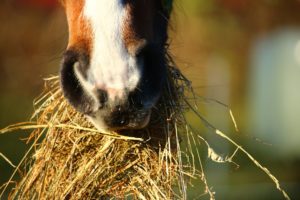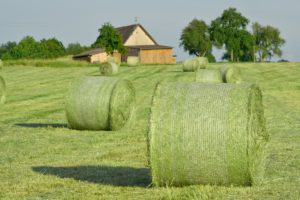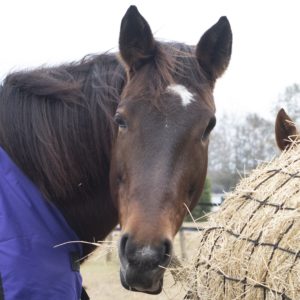 As we head further in to fall it seems that already many areas are facing challenges to their hay supply. Be it suppliers unable to provide larger amounts of hay for fear of running low, prices jumping to new heights or farmers with reduced yields and cuttings due to drought, running short of hay is something that can affect every horse owner.
As we head further in to fall it seems that already many areas are facing challenges to their hay supply. Be it suppliers unable to provide larger amounts of hay for fear of running low, prices jumping to new heights or farmers with reduced yields and cuttings due to drought, running short of hay is something that can affect every horse owner.
So how can you stretch your hay further and what options are there to reduce waste?
Forage should be the foundation of every horse’s ration and ensuring that it is provided at the correct level is key. Obviously under feeding is not desirable in any form, however over feeding can be problematic for long term health, as well as wasting valuable forage and money.
The average horse should be provided with 1.5% of his body weight in forage dry matter per day. However, for those needing weight gain or those in higher need life stages (lactating mare for example) 2-2.5% may be needed, whereas good doers needing to lose weight or high-performance horses may only consume 1% of body weight per day. This shows the importance of performing a body condition score, as well as accurately assessing their workloads as this will ultimately determine how much they receive and if their forage needs are met.
Dry matter is the weight of the forage minus its water content. Generally, the dry matter content of hay would be around 90%. However, an analysis would give you a better indication of this as well as details of the hays overall nutritional value, once again allowing you to better asses your horse’s needs.
For example, a 1100lb horse needing 1.5% of body weight in forage per day would need 18.3lb of hay per day.
1100lb x 0.015 (1.5%) = 16.5lb
16.5lb / 0.9 (90% or exact water content) = 18.3lbs.
As you can see factoring in the dry matter ensures that we are always feeding the correct levels. Its also worth investing in a small luggage scale which you can use to weigh your net or even a feed bag filled with the desired amount. This will allow you to accurately measure how much hay is being fed to again avoid over or under feeding. Do not forget to tare the scale with the empty hay net or bag so that you get an accurate hay weight.
Once you know the weight of hay needed for each horse to meet its requirements minimum forage intake, you can determine how much hay would be needed each month or year and purchase accordingly. When hay supplies are limited, if your horse is unable to maintain condition on this minimum forage intake each day you will ned to provide calories from another source of feed such as a performance or senior feed or use a hay substitute. How to use these products will be explained in a future blog.
When supplies are limited, it may be worth considering if every horse needs the same quality. For example, saving your highest quality hay for those that are young, old, pregnant, lactating or for those needing weight gain may be prudent. It should be noted that the term “highest quality” refers to the nutritional value. All horses should be provided with a well stored hygienic product free of mold, dust and other contaminants.
Good doers may benefit from feeding lower value forage to reduce the overall calorie content of the diet. For these horses a more mature cut hay can be more beneficial, as it will provide a good fiber content without the higher calories of other hay types.
A recent study (Jansson et al, 2021) showed that replacing 50 percent of a horse’s daily allowance with good wheat straw could be beneficial in prolonging feeding time without increasing the risk of EGUS (a previous concern of researchers). Which shows that using forage alternatives may be an option for some horses. However, do note that mycotoxin risk does increase with straw products and so analysis would be highly recommended before feeding. An alternative like this would need to be introduced gradually overtime to ensure that the digestive wellbeing of the horse is not put at risk and it should also not be the only forage source in the diet.
Every time you change your hay supply the risk of colic increases and so buying in bulk avoids changes mid-season. It also has the advantage of allowing you to buy before prices increase in mid-winter. Having a consistent long-term supply also allows you time to test your hay and then build a more specific diet plan around that profile.
Keep in mind that once again you should only buy what you need (plus a bit extra of course). Nutrient levels in stored hay do decrease over time and its likely that by the time hay is 12 months or older, additional support will be needed to meet basic daily requirements on some nutrient levels.

Ultimately the decision on what size bale to use will come down to the individual set up and size of the property in question.
Small square bales are generally easier to store, and handle as they can be kept inside and don’t require machinery to move, for the induvial horse owner/small barn they are also easier to feed.
Large round bales however have the advantage when feeding larger numbers of horses as well as ensuring that you have a good supply level. However quite often wastage is higher with round bales as the outer layer is not often eaten well and if feeding them in the paddock significant amounts are often trampled into the ground, not to mention the losses when filling up hay feeders for smaller numbers of horses as you pull the hay from the roll. Round bales also generally need to be stored outside which exposes them to adverse weather conditions if not stored correctly. They are also exposed to the elements when left out in paddocks for big groups, which can result in an increased risk of mold and botulism, so only consider using if the herd is big enough to consume within a few days.
A combination of round and small bales may be a consideration for some barns so that round bales can be placed in the field for larger groups, but square bales be used for feeding once the horses are stalled. Regardless of bale size wastage all adds up and can be costly for any size operation so taking the time to minimise this can be highly valuable. Hay wastage can be reduced by using some kind of feeder.

There are many options when it comes to hay feeders and which one to choose will largely depend on your personal set up and what you ultimately want to achieve by using one, as well as cost and ease of use. But the aim is to prevent hay loss by keeping hay off the ground or stall floor reducing the risk of contamination with fecal matter, sand and dirt, as well in some cases protecting hay from the environment. It has been shown that some feeders can reduce wastage by up to 85 percent.
Feeding on the ground, although it is generally considered to be the most wasteful, does have the advantage of allowing the animal to adopt a more natural grazing position. If stalls are kept clean regularly there should be no issue with feeding in this way however it’s not generally recommended for deep litter systems or feeding outside.
The more common feeders used are hay nets, hay bags or hay racks. Hay nets and bags have the advantage of coming in different hole sizes, with smaller sized holes being useful for slowing a horse’s feeding rate down which in turn can improve digestive health especially in situations where a continuous flow of ingesta is important such as assisting in the reduction of gastric ulcer risk. These are also certainly the most practical feeder for horses that travel.
 However, keep in mind that a feeder should not be frustrating for the horse, as this can reduce the amount of hay they are inclined to eat. This can sometimes happen with feeders that have small holes or those that pack hay in tightly making it hard to pull out.
However, keep in mind that a feeder should not be frustrating for the horse, as this can reduce the amount of hay they are inclined to eat. This can sometimes happen with feeders that have small holes or those that pack hay in tightly making it hard to pull out.
Hay racks can be useful as they generally are larger and allow more hay to be provided in one go which is useful if visits to the barn are restricted to less times per day but keep in mind that racks and nets should be placed at heights whereby the horse has access but prevents the horse from getting caught in them.
The higher height position of such options do mean however that there is a more unnatural neck position which can have repercussions on the horse’s back position and jaw angles throughout the hours horses are pulling hay from their slow feeders according to new research (Raspa et al 2021).
It is therefore, advisable to look for nets/bags that can be used safely at slightly lower angles. Freedom feeders and Haychix are both good options in these situations.
Fixed stall feeders are a good option for those wanting lower neck positions but with the safety of a more solid knee height feeder. These should be well made with no protruding parts. These can sometimes come with nets over the open part which further slow feeding.
For those feeding outside consider placing something under your feeder or find a feeder that has an inbuilt trough which will capture the small leaf matter (which is highly nutritious) and is especially important if leaves are prone to shatter such as when feeding alfalfa. Also look at feeders that are lower to the ground for not only head position but to reduce the amount that can be blown away in high wind areas. Hay optimizers are a great option for feeding horses at pasture and cab ne used for individual horses or groups.
If you are feeding round bales, a feeder that helps to provide protection from the elements is ideal and it will vastly stretch the longevity of the hay. Hay huts are great for this use and are simple and easy to use.
Remember that adding anything extra to a stall or field should be done carefully and should be monitored regularly to ensure continued safety for your horse.
Research articles noted:
Jansson, A., P. Harris, S.L. Davey, N. Luthersson, S. Ragnarsson, and S. Ringmark. 2021. Straw as an alternative to grass forage in horses: Effects on post-prandial metabolic profile, energy intake, behaviour and gastric ulceration. Animals (Basel) 11(8):2197.
Raspa, F.; Roggero, A.;Palestrini, C.; Marten Canavesio, M.; Bergero, D.; Valle, E. Studying the Shape Variations of the Back, the Neck, and the Mandibular Angle of Horses Depending on Specific Feeding Postures Using Geometric Morphometrics. Animals 2021, 11,763. https://doi.org/10.3390/ ani11030763